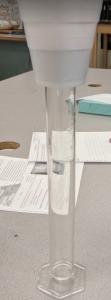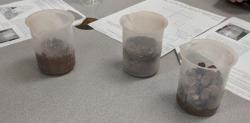Porosity and Permeability Lab
Porosity and Permeability Lab
In this Earth Science lab, I first discuss with students what soil permeability and porosity is and why that matter. The more permeable a soil is the easier the soil drains water. Some plants prefer water to be drained quickly. Soil porosity is how much space is in between the different sediments. A good way to see if soil is porous or not is to see how much water it can soak up or hold onto. Some plant prefer water that can hold onto water so that they constantly can use it.
At the high school level, I have the students first take a guess as to which substrate is most porous and which is the most permeable. I don't tell the students how to do the lab at all. I provide each group with 6 Styrofoam cups, three beakers, at stopwatch, a paper with a coordinate plane and table, and one graduated cylinder. I stress that this lab is really focusing on data collection. As they try to find out which substrate is the most porous and permeable, they have to have some numerical values attached to it.
Students first have to make a plan before they execute it. They need to write their step by step procedures, make their observations, collect data, and make a conclusion based on their data. The lab for the most part takes only about thirty minutes. I have the students present their ideas to the class, where we discuss gaps and successful ideas in their scientific reasoning.
You can purchase the lab worksheet that goes with this lab at Teacher Pay Teacher for 0.30 cents.
Below are some images of ideas my students came up with and a video that demonstrates one of the better solutions.












